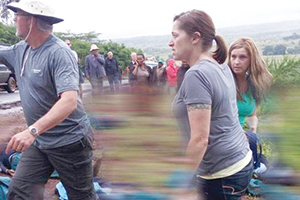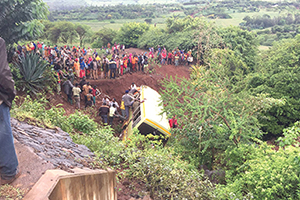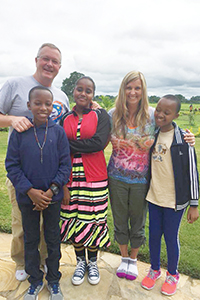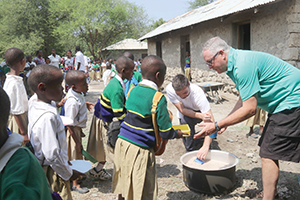By DALE SINGER
The three medical missionaries from Sioux City, Iowa, area were running late for a safari excursion they had booked at the last minute for their unexpected day off in rural northeastern Tanzania. But before they would see a wild animal that day, fate intervened with a force that would resonate across cultures and continents.

Kevin Neegard; Manda Volkert, foreground; and Jennifer Milby triage patients at a school bus crash in Tanzania on May 6 of last year. The women are nurses at Mercy Medical Center clinics in the Sioux City area. Neegard is executive director of Sunnybrook Community Church in Sioux City, Iowa.
When the vehicle they were riding in rounded a bend, they were witness to the immediate aftermath of a fatal school bus crash. The bus had careened off a wet road and plunged into a ravine. One member of the missionary group, Jennifer Milby, a nurse practitioner in a clinic affiliated with Mercy Medical Center–Sioux City, insisted their driver stop and let them out to join in the rescue. The three triaged the victims being pulled from the bus and are credited with helping save three young victims of the accident that killed 35 others, 32 of them children. The children, all in the seventh grade, were on their way to take a practice exam.
Milby, Kevin Negaard and Manda Volkert don't think of themselves as heroes, although others beg to differ. The three are being honored Oct. 10 with this year's Hospital Heroes Award from the Iowa Hospital Association.

Local men form a chain to carry 38 people, including 32 seventh graders, from a school bus that crashed near Karatu, Tanzania on May, 2017. Three medical missionaries from Sioux City, Iowa, who happened upon the crash, set up a triage site atop the hill to check for signs of life. The crash claimed 35 lives.
"This is what we do," said Milby. "I would have done it anywhere, any day. I don't feel like what we did was heroic. I don't know of any health care provider who wouldn't have stopped."
Added Negaard, who is executive director of Sunnybrook Community Church in Sioux City: "We're not heroes. We're people who responded to God's call at this certain moment. We were the last three to sign up for this trip," having done so just three weeks before the departure date of the Siouxland Tanzania Educational Medical Ministries group. "Obviously God's timing was perfect, for us to be there at that moment."
Healers' instincts
The moment came on May 6, 2017, outside Karatu, which is near the Serengeti Plain. Because of a scheduling snafu, Milby, Negaard and Volkert, a registered nurse at a Mercy Medical Center clinic, had a free day, and Dr. Steve Meyer, a Sioux City physician who founded and heads Siouxland Tanzania Educational Medical Ministries, said they should enjoy themselves on safari.
They were delayed a bit, when Milby returned to camp for her camera, and they stopped to buy souvenirs on the way. Then they saw people standing on the side of the road and the bus perched precariously on the steep slope of a ravine.
"I told the driver he had to stop," Milby said. "He said he wouldn't stop, but I kind of lost it and started screaming that he had to stop. They were just pulling body after body out of the bus and handing them up to people at the top."

On a return trip to Tanzania this year, Kevin Negaard and Jennifer Milby reconnect with, from left, Wilson, Sadhia, and Doreen, the three Tanzanian bus crash survivors whom they cared for immediately following the accident.
The three checked victims for breath and pulse. They found five children with heartbeats; four of them were unconscious. All had open fractures in their arms where they braced in an attempt to protect themselves as all the seats broke loose when the bus plunged down the hill. "Most of them died from broken necks from the impact" of the bus hitting the hill, Negaard said.
Wilson, one of the survivors, "was conscious and remained conscious all the time. He could speak in English. He had a huge head laceration and open fractures, but he was very calm and talked to us," Negaard said.
Negaard said a transport van stopped and its passengers disembarked; the children were loaded into the back for the trip to the nearest hospital in Karatu. One child died on the way to Karatu. Wilson, Sadhia and Doreen hung on and they were transferred to the intensive care unit in a hospital in Arusha, the nearest city. The remaining survivor died on the way to Arusha.
Focused calm
Negaard had been an athletic trainer and he said that experience helped him stay focused on the tasks at hand at the accident scene, though he had never faced circumstances this dire. "The biggest thing my background taught me was how to be calm in that situation," he said.
Once the children were en route to the hospital, Negaard, Milby and Volkert decided to stick with their safari plan. "Otherwise," he said, "we'd just go back to our hotel" and think about the catastrophic accident.
But their involvement with the survivors was far from over.
The following day the three medical missionaries saw a shopkeeper reading a newspaper. Negaard asked one of the drivers who had taken them to the shopping area to inquire if the paper had news of the surviving children. The driver returned with the Swahili language paper which named the hospital where the children were receiving care. A photo of the three Iowans was on the front page. Negaard said the group went to the hospital where they were recognized by the Minister of Health. Visiting hours were over, but the health minister escorted them to the ICU to see the children.
Soon, the missionaries realized that for the children to fully recover, they would need more advanced treatment than they could get in Tanzania. The children had 20 broken bones between them. Doreen had severe facial and jaw injuries that prevented her from talking, and spinal injuries that paralyzed her from the waist down. Sadhia also had a broken back.
Getting to yes
Meyer reached out to Mercy Medical Center–Sioux City, where co-medical directors Dr. Steven Joyce and Dr. Larry Volz offered assurance that the hospital would provide surgery and other medical services at no cost. From there, things moved quickly. Samaritan's Purse, a faith-based international relief organization, arranged for the children, their mothers and a Tanzanian doctor and nurse to be flown to Sioux City. Eight days after the accident, the children were being treated at Mercy Medical Center. The mothers checked in for an extended stay at Ronald McDonald House, where they would later be joined by their children, who received physical therapy and counseling as outpatients following inpatient treatment and surgeries.
"So many people said yes," Negaard recalled. "Mercy hospital never questioned, said yes, we would treat them. Surgeons said they would operate.
"We were on our knees, thanking God that these kids were going to have a chance."
Back in Iowa, Milby, Volkert and Negaard saw the children frequently and watched them make great progress physically and emotionally.
"It was very cool to see," Milby said. "Sadhia loved chocolate cake. She had never seen a computer before, but she learned to use it."
Homecoming
Three months later, the children went back home. Doreen was walking with crutches and talking by then. Milby, Volkert and Negaard have made return journeys to Tanzania as well, including a visit for a memorial marking one year since the accident.

Negaard, far right, dishes up a rice and beans lunch to school boys at a government run primary school in the Mbuguni region. Negaard says that since the Siouxland Tanzanian Educational Medical Ministries began providing lunch at the region’s six schools, the district’s national exam pass rate has jumped to 82 percent from 43 percent.
"That was hard," Milby said. "The kids seem like they've healed emotionally, but they got emotional when they had to get up to talk about their friends.
"It was really tough, but it was also inspiring, because they had so much love and respect. They want to be good representatives of their country, as survivors."
"They're the strongest, most resilient kids that you'll ever meet," Negaard added.
The accident changed not only the lives of the children but the lives of their rescuers as well. They didn't know each other before the mission trip, but now they're close. Volkert, who prefers a low profile, didn't want to be interviewed about her experience, but Negaard said Volkert was an integral part of the effort to assist the survivors.
"We all deal with it differently," he said. "Jennifer dealt with it more at the time. I think Manda's way to deal with it is to be quieter, more introspective. But it's more about how the three of us came together and how God worked through us in three very different ways."
Milby said the experience changed her in fundamental ways. "I know when I went on this trip," she said, "I was struggling in my personal life with my own faith. But the more I was there, I saw God had this plan in mind. My faith was restored."
Negaard said he wants to make sure the kids have every chance in life. Three Siouxland residents are paying their high school tuitions. "We are working to assure they have the opportunity to attend college in America, if they would so desire," said Negaard. For now at least, Sadhia wants to be a pilot, Wilson an engineer and Doreen a science teacher.
Copyright © 2018 by the Catholic Health Association
of the United States
For reprint permission, contact Betty Crosby or call (314) 253-3490.